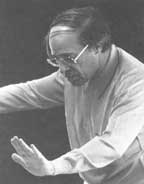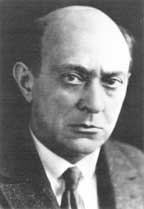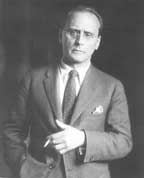A new musical grammar: principles and early experiments by Pierre Grondines
/ November 1, 2000
Version française...

Around 1944, when Pierre Boulez, then a young student at the Paris Conservatory, asked his teacher which composer had the ability to lead modern music out of its current impasse, Olivier Messiaen reportedly answered, "You, Pierre!"
Of course, it is a mistake to think there was only one way out of the musical impasse perceived by a nineteen-year-old Boulez. Possibly no impasse really existed. However, we must at least credit Boulez with a major contribution throughout his career to the development of a rigorous and innovative approach to music that marked his era–in a word, serial music. The purpose of this article is to take a closer look at what lay behind this development. In a later article, entitled "Serial Music Becomes Respectable," we will see that a work such as Le Marteau sans maître, which is the result of the serial technique, demonstrated the artistic viability of this approach.
Failure of the old order
During the decade after World War II, a handful of young European composers wanted to do away with the aesthetic approaches typical of the period between the wars. Composers like Pierre Boulez in France, Henri Pousseur and Karel Goeyvaerts in Belgium, and Karlheinz Stockhausen in Germany were looking for a new musical grammar. They were motivated by the recognition that neoclassical works by composers like Stravinski (post 1920), Milhaud, Poulenc, and Auric, among others, had become obsolete. Such music was sometimes trivial, sometimes contained clever allusions to the styles of great composers of the past, and seemed based on the aesthetics of illusion rather than any genuinely profound musical expression. Cases in point are Poulenc’s Concert champêtre for harpsichord and orchestra (1928), which draws on the French baroque tradition, and Stravinsky’s Symphony in C (1939), with its references to Haydn and Beethoven. Such composers were also reproached for not taking the question of musical language seriously. They were viewed as being generally content to remain within the confines of classical harmony, injecting the occasional discordant note as a cheap sop to modernity. There was an implicit moral judgment in this seemingly excessive reaction by the younger composers. We should remember that for a composer who reached his or her twenties after 1945, when Europe was slowly pulling itself out of material ruin, it was difficult not to associate the overly pleasant neoclassical music of the 1920s and 1930s with the bankrupt ethics of a period that had permitted the rise of totalitarian regimes and done little to prevent the outbreak of a second world war.

Webern: the new prophet
In the eyes of the intransigent rising generation of composers, only one of their predecessors found favour. This was Anton Webern (1883-1945), a member of the Second Vienna School that also included Alban Berg (1885-1935) and Arnold Schœnberg (1874-1951). Webern was one of Schœnberg’s disciples and an early proponent of dodecaphony (the twelve-tone system) invented by the latter in 1923. Schoenberg’s dodecaphony was inspired by the desire to give greater cohesion to atonal composition. The system advocates the continual use, in any one work, of a single "series" (or its variants), based on the twelve tones of the chromatic scale and organized according to a sequence chosen by the composer. The presence of any note in the course of the work is governed by the series. However, technique is not synonymous with style, as demonstrated by the dodecaphonic works of Webern, which are extremely concentrated and austere, and surprisingly different from Schoenberg’s compositions. When Webern was at the height of his stylistic development, he initiated a new way of envisioning musical space, beginning with a traditional counterpoint and evolving into a fragmentation of the music into short, isolated motifs, as in his Symphony op. 21 (1928). Webern disdained the use of easy musical effects. Paradoxically, Webern’s highly disciplined writing achieved an unexpectedly pleasing sound not essentially unlike the most austere portions of Bach’s music. By about 1950, Webern’s demanding approach to musical construction, combined with the fact that his work was almost completely unknown during his lifetime, had earned him enormous moral prestige.
The music of the three Viennese composers, Webern, Berg, and Schoenberg, was little known in France until after the Liberation, when conductor René Leibowitz, an old friend of Schoenberg’s, introduced it to the young Parisian composers. The new generation was fascinated by it, and particularly by Webern’s musical ideas, which were to provide the basis for the new grammar that they were so eagerly trying to create.
Integral serialism
Taking Webern as their guide, young composers like Boulez, Pousseur, Goeyvaerts, and Stockhausen–briefly influenced by Messiaen (Mode de valeur et d’intensité for piano, 1949) and stimulated by the exchange of ideas during the Darmstadt summer festivals for new music in West Germany–worked out a new musical grammar in a climate of almost feverish mutual emulation. They called it by various names: serialism, integral serialism, post-Webernian serialism, and so on. According to this new musical approach, it was permissible to apply to all of the characteristics of a sound (duration, dynamics, etc.) the type of treatment that Schoenberg’s twelve-tone system reserved for pitch only.
From then on, a mere series of pitches was not enough. Before writing a single note, the serial composer must also have other types of series in mind, each destined to govern a particular aspect of the sound. In addition to the traditional series that determined the order of appearance of all pitches in the work, one should envisage other series involving the duration of each of these pitches (a half note, a sixteenth note), the dynamics (forte, pianissimo), and so on. In the final analysis, each note written down was the end product of the conjuncture of these series.
This approach, in which the composer renounced the ad hoc control of the musical progress in favour of predefined series, produced such works as Polyphonie X (1951) and Structures I for two pianos (1952) by Boulez, the Sonata for Two Pianos (1951) by Goeyvaerts, and Punkte (1952) by Stockhausen. These initial products of integral serialism were fiercely athematic. They also cultivated in varying degrees the perpetual "saw-tooth" musical profile as well as a pointillist effect–to borrow the term used for Georges Seurat’s painting technique–which meant giving each sound an extremely individual character.

"Give us works!"
By their own admission, these young composers soon felt that the musical language of their first serial works was too constricting and almost mechanical. They, once so intransigent toward their predecessors, were now in danger of being accused of building numerical structures on their staves. "Let them give us [real] works!" said the impatient Georges Auric in the 1950s. The advocates of integral serialism quickly realized that while their initial attempts were legitimate and necessary, they now had to demonstrate the validity of the new grammar in artistic terms by producing works that were totally convincing
[Translated by Jane Brierley]
(Next issue: "Le Marteau sans
maître ": Serialism becomes respectable.)
Pierre Grondines is a choir director and musicologist. He teaches at the Conservatoire de musique de Québec and in the music department of the Sainte-Foy CEGEP (junior college) in Quebec City.
Version française... |
|


